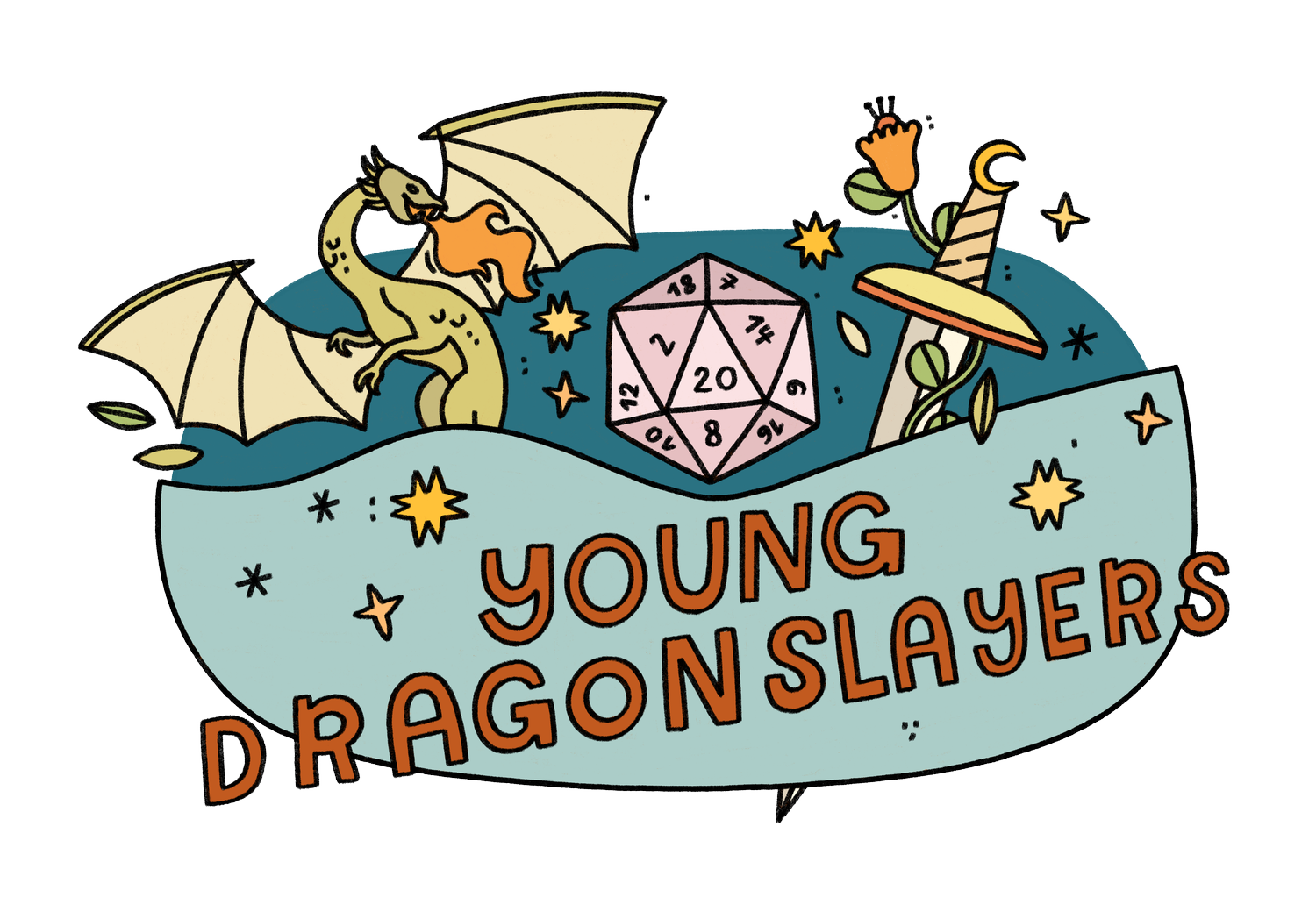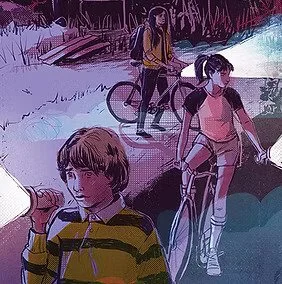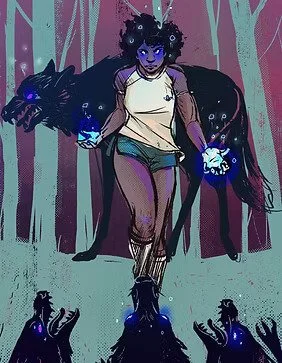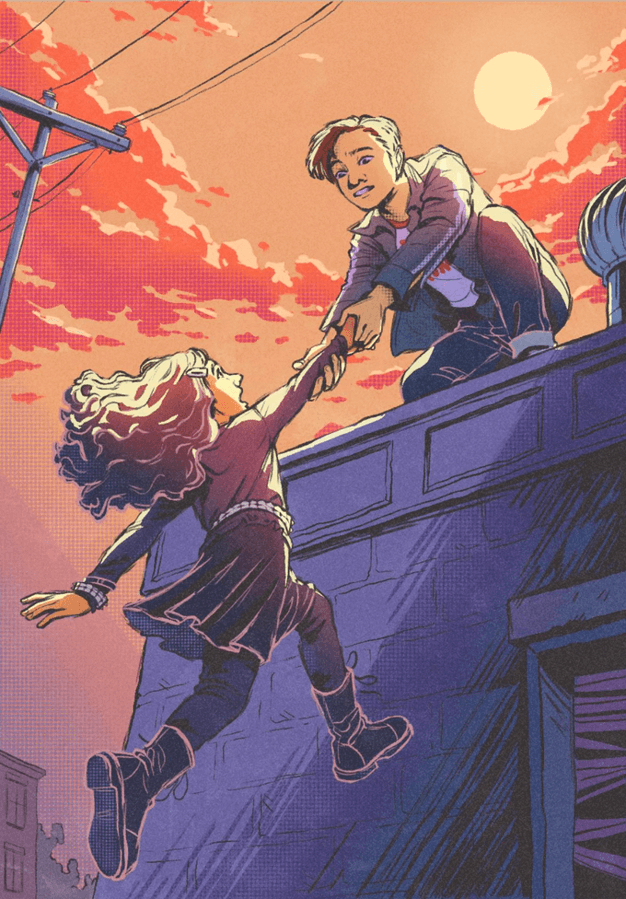How Two Friends Made Stranger Things in DND
Dungeons & Dragons is a key element of Stranger Things. The characters not only play D&D in the show, but the game impacts their relationships, how they see the world, and even what they call the monsters they encounter! There’s also just a lot of natural crossover between Stranger Things and D&D. Both have a team of heroes who investigate strange happenings, fight both monsters and humans, and save the day. I got to chat with Jonathan Gilmour-Long, a game designer and Stranger-Things fan who co-created his own D&D Stranger Things game called Kids on Bikes. Here’s his story, from exploring the woods and reading D&D books as a teen in the 80s to designing games in the 2000s and beyond.
Creating A D&D Stranger Things Campaign
When Stranger Things first came out, Jonathan, like many of us, fell in love with the show. Because it’s set in the 1980’s, there’s an added sense of mystery for the characters: there’s no Google to tell them the history of the Creel house, no GPS to find where Mike or Lucas get off to when they leave their walkie-talkies, and no camera phones to snap a picture of the Demogorgon or the Mind Flayer. “I definitely think it was the nostalgia factor for adults,” said Jonathan, “We could go out and explore our neighborhoods and our backyards and all these places that we don't really do as much anymore.” That sense of the unknown appeals to a younger audience too, which the Kids-on-Bikes designers tried to capture as they developed their own D&D-style adventure. “[Young players] really get into the mystery of it,” said John “I think that world that’s not familiar to them is an interesting thing….Everything gives it a little bit of otherworldliness.” The gameplay of Kids on Bikes runs similarly to a game of Dungeons & Dragons; players play characters, pick stats, roll dice, and use abilities in a world crafted by the Game Master. But instead of a world of wizards and fireballs, this is a world of midwest towns and supernatural forces – a Stranger-Things world!
Jonathan bonded with his co-creator, game designer and English teacher Doug Levandowski, over their shared love of the show. “Doug and I both grew up as huge fans of that genre of things. Goonies or E.T. – all of those are really Kids-on-Bikes-style movies,” said Jonathan, “We just both love that child-like sense of wonder about the world and that there's adventure everywhere. Both of us watched Stranger Things when it first came out. Doug had posted ‘Who wants to work on a Stranger Things board game?’ And I messaged him ‘I already started a Stranger Things board game with somebody else, but what about a Stranger Things RPG?’ And he was like, ‘Incredible, that's perfect.’” And so it was.
Dungeons & Dragons in the 1980s
Growing up exploring the midwest wilderness in the ‘80s wasn’t Jonathan’s only connection to the Stranger Things characters. As a young teenager, Jonathan was also into Magic: The Gathering, Dungeons & Dragons, and a wide variety of video games. “I’d really consider myself an omni-gamer,” said Jonathan, “I love party games; I love big, heavy Euros, and I love tabletop RPGs.Those definitely got harder to play as I got older and busier. It’s really hard to organize a D&D group!” Though he played passionately, Jonathan’s relationship with D&D was rocky from the beginning. “I knew from reading and hearing about [tabletop RPGs], that they were these things that could tell these great stories. I wasn’t a good writer, but I had a great imagination. I loved playing make-believe my entire life. But all these games had this huge promise of telling a story that I just wasn’t able to find.” Why? He couldn’t figure out how to play. “Dungeons & Dragons is not a good rulebook. And I say that in that it's a 300-page player guide that doesn't teach you how to play the game at all. Dungeons & Dragons flourished because of people teaching other people to play.” But Jonathan grew up in a small town which, unlike Hawkins, had no Hellfire Club, no Mike or Eddie to teach a young nerd how to play. “Not being able to learn how to play [tabletop RPGs] affected me pretty deeply.” Even in adulthood, when he had been playing for years, he struggled. “Every system I would learn and try to run, I just felt like it was almost impossible for me to understand all the rules in a way that I could teach them to everybody at the table,” said Jonathan, “That was stopping me from playing, triggering those same feelings of missing adventure and missing that sense of telling stories together.”
D&D Stranger Things Character Sheets to Learn in 5 Minutes
Jonathan took these experiences to heart when he designed Kids on Bikes. He wanted it to have the same adventure and storytelling of D&D, but without the confusing 300-page rulebook. “It really inspired me…to think of ways to design an RPG that I can teach to somebody in 5 minutes and still satisfy what I want, crunch-wise, from an RPG,” said Jonathan. But he still wanted to pay homage to the D&D’s place in Stranger Things. “D&D, even in the first season, was almost a character in the show,” said Jonathan, “When Doug and I were working on Kids on Bikes at first, we had a lot of conversations about the nostalgia of D&D as an important part of Kids on Bikes, and how could we bring that in,” said Jonathan. They decided that they’d assign each stat to one of the polyhedral dice used in D&D: d4, d6, d8, d10, d12, and d20. “Then you get to have your character sheet with all these D&D dice on it….It has that cultural touchstone of ‘I get all these shiny math rocks, and I get to use them’ but they're used in a different way.”
So how does that work in the game? Well, the difficulty class (DC) of a die roll stays the same – a 4 is pretty easy, while a 8 is fairly difficult, a 14 is wildly impressive, and a 20 (the maximum) is basically impossible. But the die the character rolls to hit that difficulty class is different – say a d12 for their Brains stat, but a d4 for their Brawn stat. But it’s not entirely impossible to succeed on a given roll; every time you roll the die’s maximum value, you get to roll again and add that value to your roll. You could conceivably roll a 4 on a d4 five times in a row and beat any check! Doug and Jonathan also took inspiration from the Fate Points in Fate Core. In Kids on Bikes, players earn an Adversity Token each time they fail a roll. Going forward, players can spend an Adversity token to add +1 to another roll. “We're both huge board game fans, too, and it's that intersection of board games and tabletop RPGs that [is] really interesting to us. We didn't want the skills to be like Dungeons & Dragons, where if you have swimming, you just get +1 when you swim. Like, that's not exciting to us. We wanted the skills to be these cool mechanical things that you could spend your Fate Points on. We wanted these little board-gamey aspects to the RPG.” The end result is a game that gets moving quickly, with more story and fewer rules.
Crafting The Perfect Stranger Things D&D Game
Even as a designer, Jonathan took a while to get used to this new, more flexible style of RPG. “We have this monolith of RPG styles,” said Jonathan, “‘You’re the players, I’m the Game Master, I have this story I want to tell’….I felt anxiety and pressure as a GM to know all the answers ahead of time. I couldn’t fathom not having a town map that had everything the players could possibly want drawn on it, so when they asked me where the blacksmith is, I could take out the map and say, ‘It’s right here.’ And it wasn’t until I started reading Powered by the Apocalypse – that style – where I was like, I can just say ‘The blacksmith is over there,’ and I can draw it on the map at that point. And I think it's really freeing to GMs as well to not have to do all of that prep. [A traditional RPG style] doesn't mean that you're not contributing to the story, and that you can't still do all these grand things. I think it just leads us to a style of play where the players feel like they have less permission to do it.”
This led the pair to an element of Kids on Bikes directly inspired by Stranger Things: Eleven – the powered character. “Whether it's Goonies with Sloth, or Gremlins with Gizmo, there's always this special kid. So that's a big touchstone for us.” Rather than having a single player control the powered character, each player at the table gets to control a certain trait of that character. Early on, these might be simple, like “doesn’t trust strangers” or “no social skills” but as more gets revealed, these traits can be powers like “telekinesis” and “opening portals to the Upside Down” Together, the easy-to-learn mechanics, narrative flexibility, and the Stranger-Things touchstones, like the setting and characters, make Kids on Bikes a great choice for Stranger Things fans who want to pick up a game as a group and get playing quickly.
Play Your Own Stranger Things D&D Adventure
But some may still want to dive into the world of Dungeons & Dragons proper, playing wizards, sorcerers, and rogues in a land of myths and magic. Luckily, we live in the age of the internet, where a YouTube video can substitute a 300-page rulebook, and a WiFi connection can bypass even the smallest of small towns with online clubs like ours. Our professional Dungeon Masters already know the D&D rules and can teach you how to play without cracking open a book. We also craft adventures based on your interests (as I write this, my players have just entered the Upside Down on their search to capture a T-Rex with Jinu). We put players in groups with similar ages, play styles, and interests to make sure everyone has a good time. “[Playing D&D in youth] would have been huge,” said Jonathan, “It would have been incredible to have that kind of structure and friend group.” We hope we can offer that exact experience to the next generation of gamers. Find out more information about our games – and Kids on Bikes – via the buttons below.






